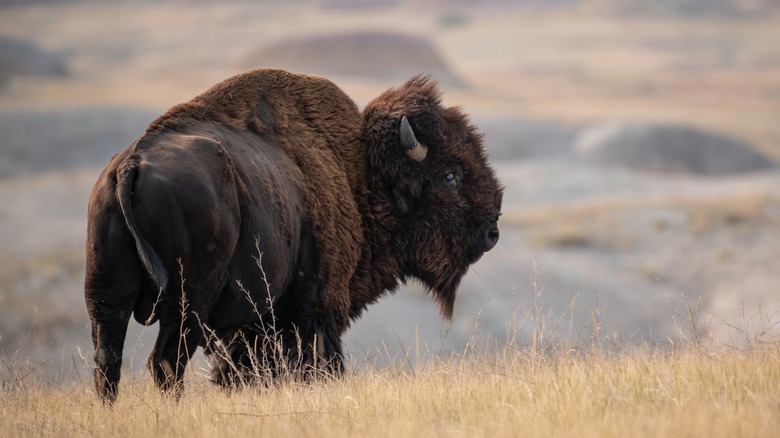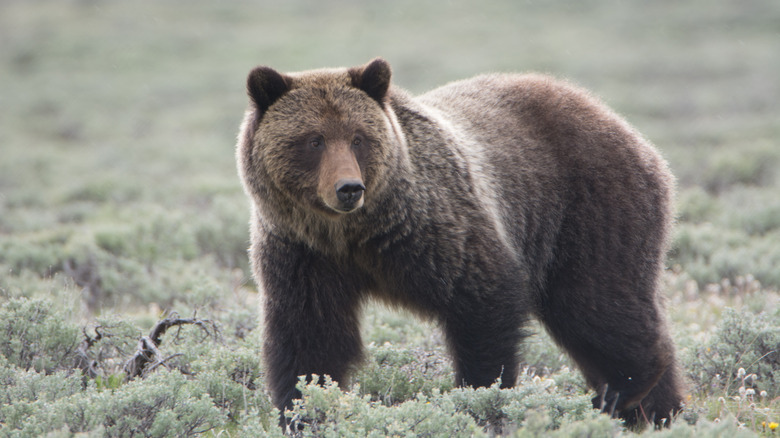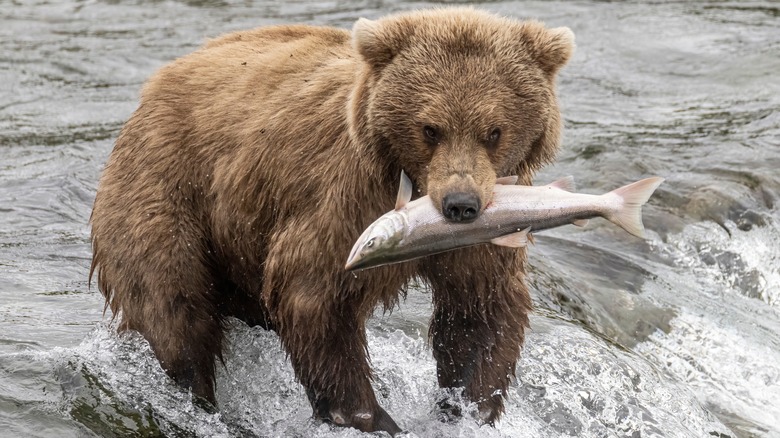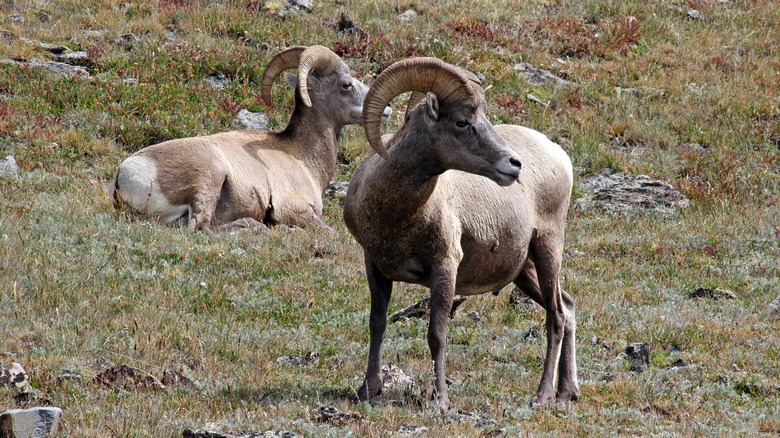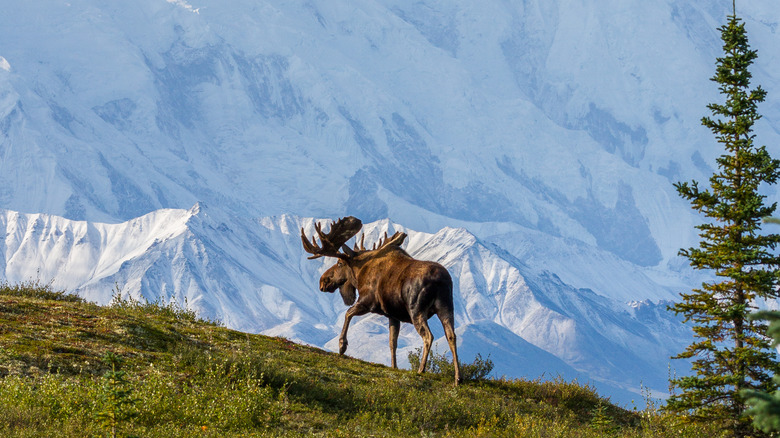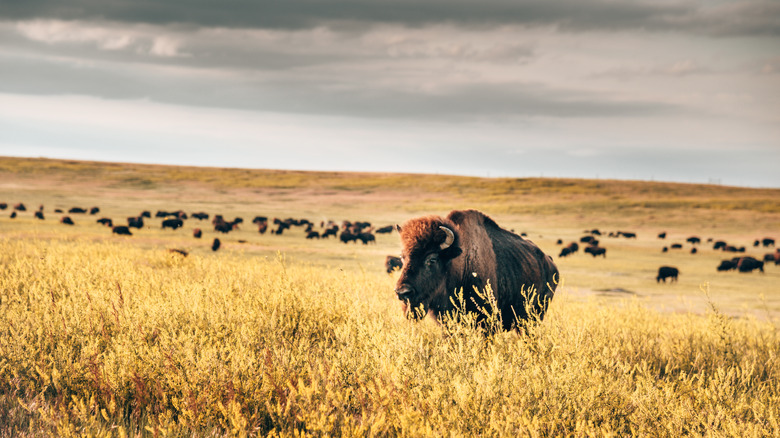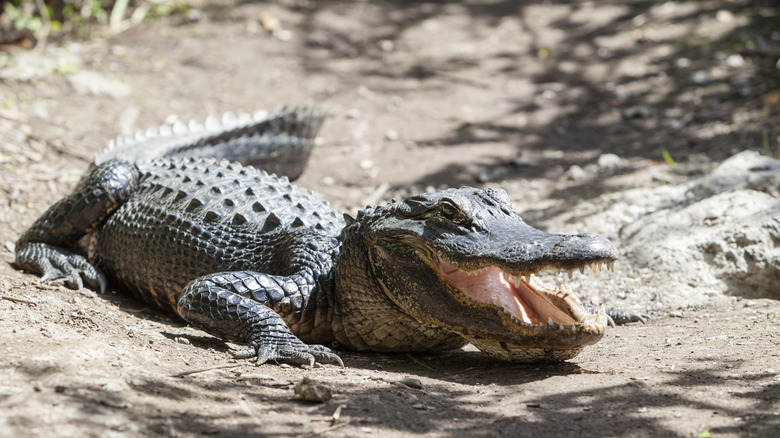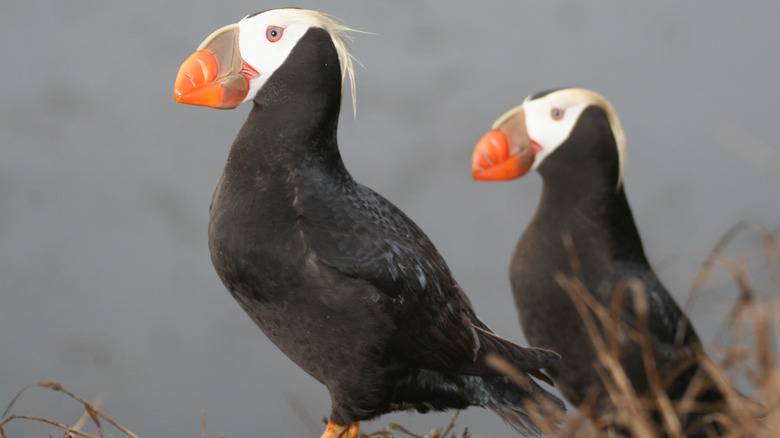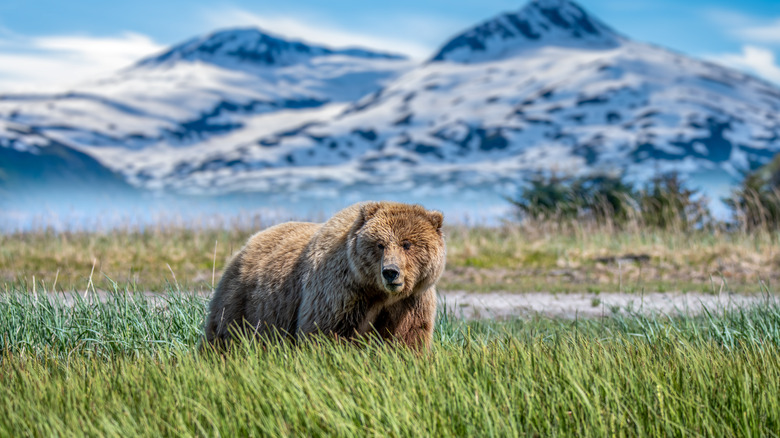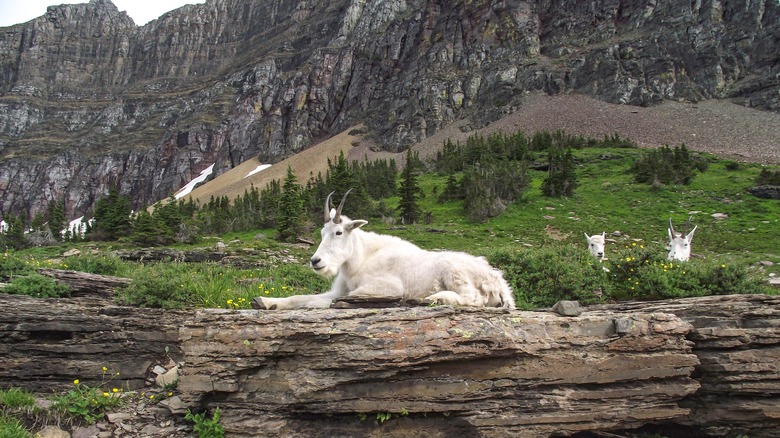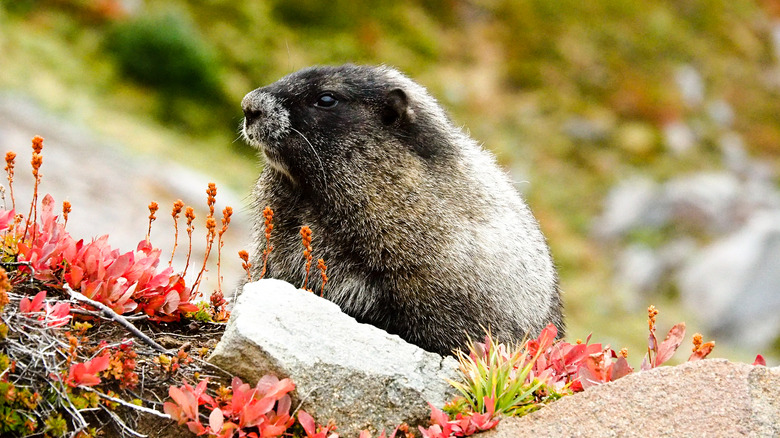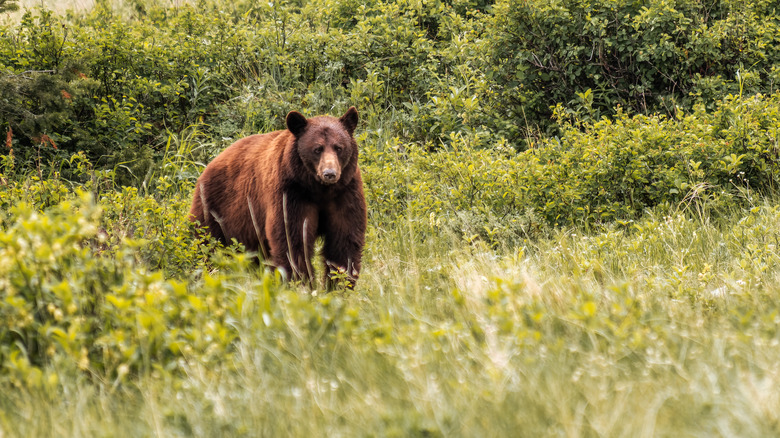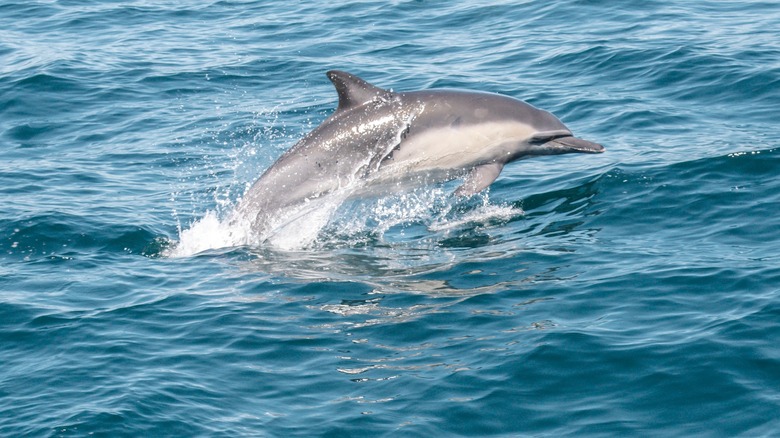The 12 Best US National Parks Where You Can Actually See Wildlife
One of the main purposes of the national park system is to protect wildlife habitats. With 63 parks covering more than 84 million acres, that's a lot of wildlife. If your main goal is spotting animals in their natural habitat, you should know that some parks are better than others. Katmai National Park's brown bears, alligators in the Everglades, the Channel Islands' whales and dolphins, and the largest herd of bison in the U.S. at Yellowstone — to name a few — should be at the top of your list.
Watching animals in the wild is an exciting adventure, but it comes with great responsibility. Always remember that you are a guest on their land, so tread lightly and keep your distance. With that in mind, read on to learn more about where to go for the country's best wildlife-viewing opportunities. Then, grab your binoculars and get ready to head out into the wilderness.
Yellowstone National Park
As the first national park designated in 1872, Yellowstone has a special place in history. Encompassing 2.2 million acres in Wyoming, Montana, and Idaho, it's also incredibly massive — the eighth largest of all the national parks. All that land means plenty of room for wildlife species to flourish — in large numbers. Notable among them is the biggest free-roaming herd of bison in the U.S., as well as one of the largest elk herds.
Yellowstone is also home to one of the last grizzly bear populations in the contiguous United States. A top location for spotting these impressive mammals is the Lamar Valley. Easily accessible via Highway 212, you can stop the car in a paved pullout for a prime view. Other wildlife-viewing hot spots include Hayden Valley and the Tower-Roosevelt area.
Spring, summer, and fall are the best times to visit the park for wildlife viewing. You can potentially see bears, bison, and elk any time of day in the park, but you'll have the best chances just after sunrise and before sunset. This is the coolest part of the day when they will likely be out searching for food. Although less likely, you may also be able to spot one of the more than 100 gray wolves that live in the park. Even rare is a sighting of a wolverine or lynx. In the park's northern regions, you may also see non-native mountain goats who have made the park their home.
Katmai National Park
Katmai National Park & Preserve in southern Alaska is one of the best places to view brown bears in the wild, with an estimated population of 2,200. Bears congregate wherever there are abundant food sources. In Katmai, this is along the Pacific Coast, which is home to some of the most concentrated populations of brown bears ever recorded. However, this isn't the easiest place to see them due to its rigorous terrain and dense vegetation. The best bet that doesn't require backcountry trekking is Brooks Camp on the Brooks River, where bears gather to catch sockeye salmon in the frigid waters. Four viewing platforms allow visitors to safely watch the bears gorge themselves from a distance. July is the best time to see bears in this location, as it is the season for salmon migration.
If you are interested in backcountry bear viewing in early spring and summer, you can catch them in open meadows munching on sedges and digging for clams in mudflats. Later in the summer and fall, you can see bears anywhere salmon are running in streams. In June, your strongest chance of spotting bears in the backcountry is at Hallo Bay and Swikshak Lagoon. In July, it's Brooks Camp; in August, it's Geographic Harbor and the Moraine Creek and Funnel Creek area. In September, they're back in droves at Brooks Camp, stocking up on salmon before heading into hibernation for the winter.
Rocky Mountain National Park
Big game abounds at Rocky Mountain National Park in Colorado, home to an elk herd of 600 to 800, 350 bighorn sheep, mule deer, and moose. You'll also find over 60 additional mammal species; at least 280 bird species; 6 types of amphibians, including the endangered boreal toad; 11 fish species; and abundant butterflies.
Elk are relatively easy to spot, especially during the fall mating season. During the cooler months, you can find them in meadows at lower elevations; in the warmer months, they congregate at higher elevations. It may be easiest to see them at dawn and dusk. To view bighorn sheep, head to Sheep Lakes between May and the middle of August. Willow thickets bordering the Colorado River in the Kawuneeche Valley are the best place to see moose, and mule deer can be glimpsed all over the park, typically in open areas at lower elevations.
White-tailed ptarmigans are popular among the 3 million people visiting the park yearly. These small grouse that change color — from all white in winter to primarily grayish-brown in the warmer months — are hard to spot. However, you might be able to catch a glance while hiking on the tundra. Other prizes for bird lovers include Steller's jays, Clark's nutcrackers, prairie falcons, and golden eagles, which are best spotted along Trail Ridge Road.
Denali National Park
Denali was the first national park designated specifically to protect wildlife, and it's well-known for its diverse population of big game and birds. Thirty-nine species of mammals, ranging in size from the diminutive shrew to the imposing moose, call the park home. Grizzlies, Dall sheep, caribou, wolves, foxes, snowshoe hares, and otters are abundant and relatively easy to view. The best way to see wildlife here is by bus traveling along Denali Park Road. Sitting high in a bus, as opposed to low down in a car, allows you to see over the brush that lines the roadside. Additionally, you'll get sighting help from your fellow bus mates — the more eyes you have looking, the more likely you are to find a prize.
Some of the best points along the road to spot wildlife include mile 9 to mile 22, where moose are most active during mid-August to mid-September; mile 39 to mile 45, where grizzly bears, caribou, moose, and bird sightings are abundant; mile 53, where the road overlooks the river, and the bears and caribou that sometimes frequent the area. The best chances of grizzly sightings are along the way from the Tolkat River to Eilson Visitor Center at mile 66. Caribou, coyotes, wolves, and foxes may be seen here as well. The wetlands between the visitor center and mile 92 are two spots to see waterfowl and beavers.
Badlands National Park
Prairie dogs aren't actually dogs but rather a member of the squirrel family. Their endearing habit of standing up on two legs and yipping makes them a much-beloved site among visitors to South Dakota's Badlands National Park. These playful mammals live in "towns" throughout the park and can be easily seen from the road at Sage Creek Campground, Burns Basin Overlook, and Roberts Prairie Dog Town. The mammoth American Bison — declared the national mammal of the U.S. in 2016 — is also abundant, numbering approximately 1,200 across the 244,000-acre park. They live primarily in the Badlands Wilderness Area and can best be viewed from the Sage Creek Rim Road.
Bighorn sheep are another of the large mammal favorites, and the park is home to about 250 of them. They're often found on rocky terrain at Pinnacles Overlook and around Cedar Pass at Castle Trail and Big Badlands Overlook. You'll often spot females with their lambs, as males remain with their mothers until they are at least two years old, and females never leave their mothers. Other mammals may be seen throughout the park, including deer and coyotes; snakes, such as the Prairie Rattlesnake; and large birds of prey. Last but not least, keep your eyes peeled for the butterflies fluttering in the prairie grasses.
Everglades National Park
Contrary to its name, there are no sharks in Shark Valley in Everglades National Park. But there are alligators — lots of them. More than 200,000 of these reptiles are throughout the park, making them easy to spot. The difference between an alligator and its close family member, the crocodile, which also lives in the park, is their snout shape, with the former bearing a U-shape and the latter a V-shape. The Everglades is the only place in the world where these two species live together. Traveling the 15-mile Shark Valley Tram Road will take you to the alligators, and time at Flamingo Marina will allow you to observe crocodiles in their natural habitat.
There are also more than 40 species of mammals in the park, including white-tailed deer, bobcats, and the marsh rabbit, which can sometimes be seen taking a swim. There are gray foxes, too — the only fox species that can climb trees. Playful river otters are often spotted in Shark Valley and the Anhinga Trail spring. And you can find the ever-popular manatee passing the time around the Flamingo Marina.
The Everglades are also one of the best places for birdwatchers, with over 360 species living in the park. One of the most colorful is the Roseate Spoonbill, often confused with the flamingo because of its rosy hue. However, unlike the flamingo, the Roseate Spoonbill is native to North America. Other avian life inhabiting the park includes pintails, wigeons, teals, geese, ducks, grebes, and doves.
Olympic National Park
There aren't a lot of places where you can see whales and bears in a single day. Olympic National Park in Washington State is one such unique location. Known for its biodiversity, it comprises three separate ecosystems — glaciers, coastline, and temperate rainforest. In the forests and meadows, you're likely to glimpse at least one of the 62 species of terrestrial mammals, including American Black Bears, Blacktail Deer, and Roosevelt Elk. Mountain lions and bobcats are harder to spot, but you might catch one stalking on a mountainside or near a stream. Mountain beavers, sea otters, marmots, porcupines, and snowshoe hares are easier to see. Dawn and dusk, when animals are feeding, offer the best opportunities for spotting one of these animals.
Olympic National Park is also known for its array of bird species — about 300 in total. Falcons, pelicans, sparrows, woodpeckers, starlings, and kingfishers are just a handful of species that can be seen if you're quiet, patient, and have a good pair of binoculars. Rich marine life populates the lakes, streams, and oceans. In summer months, pink salmon abound in the Dungeness watershed along the Gray Wolf River. The bright red bodies of spawning sockeye salmon can be seen in the Quinault River in November and December. The best viewpoint is from the Quinault Valley at Big Creek. From the coastline, you might be able to glimpse one of the 29 marine mammal species in the park, including seals, sea lions, spouting whales, and sea otters.
Lake Clark National Park
Undoubtedly, Lake Clark National Park & Preserve in Alaska isn't the easiest place to view wildlife simply because it's not an effortless place to get to. There are no highways that access the park, so the only way in is by plane. But once you arrive, wildlife viewing opportunities are abundant. Bears are one of the park's top attractions, especially along the Cook Inlet coast, where brown bears gather to feed on rich marine life. Unlike many other places in the world, bears are not threatened by humans here, and they have plenty of natural food sources. This has made them quite tolerant and ambivalent towards humans, which means visitors have plenty of chances to see them up close (well, not too close!)
Dall sheep wander the slopes of the Chigmit Mountains, where the park and preserve meet, and you can also see them on Tanalian Mountain in the Twin Lakes area. The 30,000-strong (down from 200,000 in 1999) Mulchatna Caribou Herd wanders the western preserve through the Bonanza Hills and surrounding the Twin, Snipe, and Turquoise lakes. Moose — a close relative of caribou but considerably larger — are typically present in areas below treeline, where the forest and tundra meet, as well as in burned and otherwise disturbed areas. Moose is one of Alaska's most hunted big game animals, but they are well-protected within the park's confines.
Glacier National Park
Montana's Glacier National Park is known for its bear population and is home to more grizzlies than anywhere else in the contiguous United States. You may be able to spot one of these large (and fast — up to 35 mph!) mammals anywhere in the park. Still, you can increase your chances by heading to the Logan Pass area, where they often hang out in the meadows by the visitor center, as well as on the Hidden Lake Overlook and Highline trails. Saint Mary Valley and Many Glacier are other grizzly hotspots. Head out at dusk or dawn when the bears are most active.
If you want to see the park's mountain goats and bighorn sheep, you'll also need to get out there just after sunrise or just before sunset. The Hidden Lake Overlook trail by the Logan Pass Visitors Center is a great place to see mountain goats and bighorn sheep. You may also catch sight of some smaller mammals, such as marmots and pikas. If you can't spot the tiny pikas, you might still be able to hear their distinctive high-pitched squeaks that echo through the mountains. Coyotes also prowl prairies and grasslands in the eastern area of Glacier National Park, especially in the early morning. If you want to see beavers at work constructing their dams, head to Lower McDonald Creek. And, although not commonly seen, Glacier is also home to lynx and mountain lions.
Mt. Rainier National Park
Do you know what to do if you get a little too close for comfort with a cougar? If you plan to hike the backcountry at Mt. Rainier National Park, you might want to have a game plan. Although there's yet to be a human injury from a cougar, the National Park Service says that cougar attacks are on the rise around the country. First of all, don't run! Stand your ground and try to make yourself appear as large as possible. Make a lot of noise. Once the cougar is scared away, take time to reflect on how lucky you were to get a glimpse of one in the wild — and not come to any harm in the process.
Black bear encounters at Mt. Rainier are more common because they aren't as timid as cougars. For most people, spotting a bear in the wildlife is a highlight of their trip. They hibernate in winter, but they can be seen in all park areas in warmer months, especially in subalpine forests and low-elevation meadows. Other mammals you might see include coyotes, often spotted in Box Canyon and along Stevens Canyon Road, and red foxes, which frequent the Paradise and Longmire picnic areas. You can see two types of deer year-round: the Columbian black-tailed deer populates the park's western side, and Mule deer are in the east.
Glacier Bay National Park
Wildlife in Glacier Bay National Park and Preserve in Alaska varies greatly from season to season. Late spring and summer are the driest months and the most popular time for visitors. In spring, bears start to come out of hibernation and can be seen munching on fledgling vegetation on mountain slopes or in grassy tidal areas looking for sedges. Birds migrate back to the park, including songbirds, Canada geese, trumpeter swans, and dabbing ducks. Inland bodies of water are prime spots for birding, as well as coastal areas where puffins, guillemots, and gulls congregate in nesting colonies.
Summer is the time to arrive if you want to see one of the park's most popular spectacles: humpback whales jumping out of the water. You can also catch sight of harbor seals and their pups, killer whales (which aren't as dangerous as they sound), and harbor porpoises. Hummingbirds whiz around feeders and flowerbeds in June, and vibrant red spawning sockeye salmon populate streams at the end of July. Mountain goats are also active during the summer; nannies travel in packs with their young, while billy goats travel separately, alone, or in small groups.
The colder months are best for viewing Stellar sea lions on Benjamin Island, among other places. Beavers are busy in October, building up food stores and patching their homes in preparation for winter. Bulls and bucks with full racks can be seen. In November, thousands of bald eagles gather on the Chilkat River near Haines.
Channel Islands National Park
Channel Islands National Park is often referred to as the "Galapagos of North America" due to its density of flora and fauna, many species of which are endemic to the islands. Whale and dolphin watching is a popular activity in the park, and there are 27 distinct species, including the largest population of blue whales in the world. You can also see humpback, fin, and gray whales; common dolphins, Risso's dolphins, and orcas; and several species of pinnipeds, including harbor and elephant seals and California sea lions.
Channel Islands is also one of the top destinations for birders, with 290 species. And it's the only park with its endemic species — the brilliant blue Island Scrub Jay. Sixty types of sea birds call the park home, including rare species like the California brown pelican and the Scripps's murrelet. It's also one of the best locations in the world for diving and snorkeling — a favorite diving spot of oceanographer Jacques Cousteau — where underwater expeditions through sea caves, coves, and kelp forests put you up close and personal with marine life. Starfish, vibrant sea anemones, bat rays, moray eels, abalone, octopus, California spiny lobsters, and the giant black sea bass, which can weigh up to 500 pounds, are just a few of the treasures underwater adventurers can find in the Channel Island waters.
